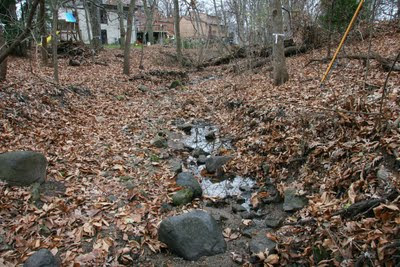Wildlife need places to drink (besides the Student Union)
Above all, wildlife need variety.
- In the water, they need pools, rapids, and slow-flowing areas.
- On land, they need cut banks for burrows, along with thickets, piles of brush or wood, and a variety of vegetation.
- In the canopy, they need a variety of trees including ones that produce nuts, and dead trees--hollow ones for dens and for woodpeckers.
Water adds variety essential to wildlife. Drawing by E. Buchbaum.
Trees alone don't attract a wide variety of wildlife, other than squirrels and birds. When you add the aquatic dimension--a stream with pools and rapids, and little "wetland" seeps, then there's a lot more variety of interesting critters.
The greenway also serves as a corridor for movement of wildlife, allowing them access to other wild areas that meet additional needs they have.
The problem with riprap and other potential solutions is that they homogenize the area, destroying the variety. Riprap isn't fundamentally hostile to wildlife, unless it eliminates the cut banks, the pools, the flowing water, and the living and dead trees. Unfortunately, riprap is bulky and uniform, and it tends to put the water out of sight.
However, I think it is possible to carefully design the greenway improvements so that the various needs of wildlife--eliminated on one place by riprap--are put back in another place. This is called "remediation." We need to see a new plan for the greenway with "remediation" for wildlife added. Option 4.
One problem with the ravine may be that it's a bit dry on the slopes during the summer. Probably it could support a greater variety of vegetation if we could create some "seeps" of the kind you see in natural ravines. Rain barrels, feeding water down to the ravine via "soaker hoses," might do the trick. Could the city share the cost of rain barrels and hoses?
What about mosquitoes?
One reader asked: "What risk is there of increased mosquitoes if standing water is significantly increased?"
There is a risk of increased mosquitoes in certain kinds of standing water pools. Normally, fish, tadpoles and other small critters eat the mosquito larvae if the stream has enough water. Probably we don't have those critters. But if there's a storm, the rush of stormwater will flush the mosquito larvae away. So, if the pool flushes or dries up in less than 2-3 weeks, no mosquitoes. That's why mosquitoes are so variable from year to year--they need just the right conditions.
Riprap doesn't eliminate the risk of mosquitoes. Water could still pool, but out of sight in the cavities below the rocks. When this happens, it's hard for the City to treat the invisible pools.
Monitoring for mosquitoes in the little pools of the greenway would make an ideal project for a middle school student. They keep track of how long the pools have existed--and use a little dipper to strain out larvae, to see if any are present.
A learning opportunity! Turn a liability into an asset. But if we eliminate all the pools, the opportunity is gone.
Yes, even mosquitoes are wildlife.
































